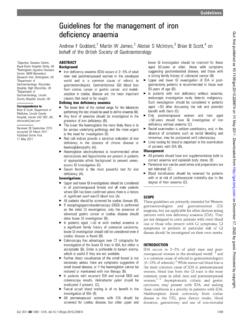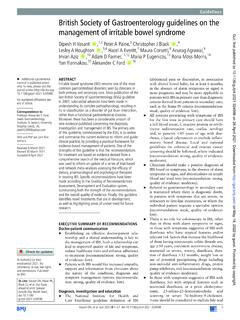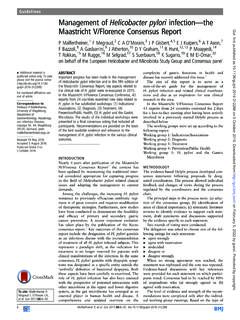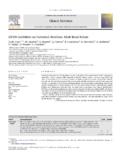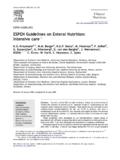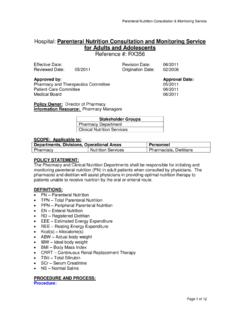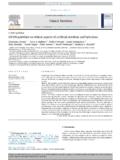Transcription of GUIDELINES Guidelines for enteral feeding in adult ...
1 GUIDELINESG uidelines for enteral feeding in adult hospital patientsM Stroud, H Duncan, J ;52(Suppl VII):vii1 FOREWORDP atients with undernutrition to a degree that may impairimmunity, wound healing, muscle strength, and psychologi-cal drive are common in UK hospital cope poorly with modern medical and surgicalinterventions and, on average, stay in hospital for approxi-mately five days longer than the normally nourished,incurring approximately 50% greater therefore aim to provide at least adequate nutritionto all patients. In the majority, this can be achieved by thecatering services if they offer good food and care is taken toavoid missed meals and to provide physical help with eating,as necessary. However, even if these ideals are met, manyhospital patients do not or cannot eat adequately.
2 Some ofthese will benefit from oral supplements but others will needactive nutritional support. This can usually be provided byenteral tube feeding (ETF).This document contains GUIDELINES covering the indica-tions, benefits, administration, and problems of ETF in adulthospital practice. The GUIDELINES were commissioned by theBritish Society of Gastroenterology (BSG) as part of aninitiative in several areas of clinical practice. They are notrigid protocols and should be used alongside clinicaljudgement, taking local service provision into FORMULATION OF GUIDELINEST hese GUIDELINES were compiled from the relevant literatureby the authors in discussion with dietitians and specialistnutrition nurses. They were subsequently reviewed by theBSG small bowel/ nutrition committee and dietetic, nursing,pharmacy, and medical representatives of the BritishAssociation of parenteral and enteral nutrition (BAPEN).
3 The strength of evidence used is as recommended by theNorth of England evidence based GUIDELINES Evidence obtained from meta-analysis of randomisedcontrolled Evidence obtained from at least one randomised Evidence obtained from at least one well designedcontrolled study without Evidence obtained from at least one other type of welldesigned quasi experimental Evidence obtained from well designed non-experimentaldescriptive studies such as comparative studies, correlationstudies, and case Evidence obtained from expert committee reports oropinions or clinical experiences of respected , many aspects of ETF have not undergonerigorous evaluation, partly because ethical considerationsmake placebo controlled trials of any nutritional interventiondifficult (see section ). Nevertheless, recommendationsbased on the level of evidence are presented and graded as:Ngrade A requiring at least one randomised controlledtrial of good quality addressing their topic of recommen-dation;Ngrade B requiring the availability of clinical studieswithout randomisation on the topic of recommendation;Ngrade C requiring evidence from category IV in theabsence of directly applicable clinical SUMMARY OF RECOMMENDATIONSI ndications for enteral feedingNHealth care professionals should aim to provide adequatenutrition to every patient unless prolongation of life is notin the patient s best interest (grade C).
4 NIt should be hospital policy that the results of anadmission nutritional screening are recorded in the notesof all patients with serious illness or those needing majorsurgery (grade C).NArtificial nutrition support is needed when oral intake isabsent or likely to be absent for a 7 instigation may be needed in malnourishedpatients (grade A). Support may also be needed in patientswith inadequate oral intake over longer on route, content, and management of nutri-tional support are best made by multidisciplinary nutritionteams (grade A).NETF can be used in unconscious patients, those withswallowing disorders, and those with partial intestinalfailure. It may be appropriate in some cases of anorexianervosa (grade B).NEarly post pyloric ETF is generally safe and effective inpostoperative patients, even if there is apparent ileus(grade A).
5 NEarly ETF after major gastrointestinal surgery reducesinfections and shortens length of stay (grade A)NIn all post surgical patients not tolerating oral intake, ETFshould be considered within 1 2 days of surgery in theseverely malnourished, 3 5 days of surgery in the modera-tely malnourished, and within seven days of surgery in thenormally or over nourished (grade C).NIf there are specific contraindications to ETF, parenteralfeeding should be considered. If patients are estimated nutritional requirements, it may be appro-priate to delay instigation of ETF (grade C)..Abbreviations:ETF, enteral tube feeding ; EN, enteral nutrition ; PN, parenteral nutrition ; BMI, body mass index; BSG, British Society ofGastroenterology; BAPEN, British Association of parenteral and EnteralNutrition; NG, nasogastric; NJ, nasojejunal; PEG, percutaneousendoscopic gastrostomy; PEGJ, percutaneous endoscopic transgastricjejunostomy; LCT, long chain triglyceride; MCT, medium chaintriglyceride; SCFA, short chain fatty on July 6, 2022 by guest.
6 Protected by : first published as on 11 November 2003. Downloaded from on July 6, 2022 by guest. Protected by : first published as on 11 November 2003. Downloaded from on July 6, 2022 by guest. Protected by : first published as on 11 November 2003. Downloaded from on July 6, 2022 by guest. Protected by : first published as on 11 November 2003. Downloaded from NETF can be used for the support of patients withuncomplicated pancreatitis (grade A).Ethical issuesNETF should never be started without consideration of allrelated ethical issues and must be in a patient s bestinterests (grade C).NETF is considered to be a medical treatment in , stopping, or withholding such treatment istherefore a medical decision which is always made takingthe wishes of the patient into cases where a patient cannot express a wish regardingETF, the doctor must make decisions on ETF in thepatient s best interest.
7 Consulting widely with all carersand family is techniquesNFine bore (5 8 French gauge) nasogastric (NG) tubesshould be used for ETF unless there is a need for repeatedgastric aspiration or administration of high viscosity feeds/drugs via the tube. Most fibre enriched feeds can be givenvia these fine bore tubes (grade A).NNG tubes can be placed on the ward by experiencedmedical or nursing staff, withoutxrays to check position must be checked using pH testing prior toevery use (grade A).NThe position of a nasojejunal (NJ) tube should beconfirmed byxray 8 12 hours after and pH aspiration techniques can be incon-clusive (grade A).NNG tube insertion should be avoided for three days afteracute variceal bleeding and only fine bore tubes should beused (grade C).NThere is no evidence to support the use of weighted NGtubes, in terms of either placement or maintenance ofposition (grade A).
8 NLong term NG and NJ tubes should usually be changedevery 4 6 weeks swapping them to the other nostril (gradeC).NGastrostomy or jejunostomy feeding should be consideredwhenever patients are likely to require ETF for more than4 6 weeks (grade C) and there is some evidence that theseroutes should be considered at 14 days (grade B).NSuitability for gastrostomy placement should be assessedby an experienced gastroenterologist or member of anutrition support team. Expert advice on the prognosis ofswallowing difficulties may be needed (grade C).NIn patients with no risk of distal adhesions or strictures,gastrostomy tubes with rigid internal fixation devices canbe removed by cutting them off close to the skin, pushingthem into the stomach, and allowing them to passspontaneously (grade A).Feed administrationNGiving enteral feed into the stomach rather than the smallintestine permits the use of hypertonic feeds, higherfeeding rates, and bolus feeding (grade A).
9 NStarter regimens using reduced initial feed volumes areunnecessary in patients who have had reasonable nutri-tional intake in the last week (grade A). Diluting feedsrisks infection and osmolality inadequate or excessive feeding may be or other experts should be consulted on feedprescription (grade C).NIf no advice is available, 30 ml/kg/day of standard 1 kcal/ml feed is often appropriate but may be excessive inundernourished or metabolically unstable patients (gradeC).NWhen patients are discharged to the community oncontinuing ETF, care must be taken to ensure allcommunity carers are fully informed and that continuingprescription of feed and relevant equipment is in place(grade C).Complications of enteral feedingNClose monitoring of fluid, glucose, sodium, potassium,magnesium, calcium, and phosphate status is essential inthe first few days after instigation of ETF (grade C).
10 NLife threatening problems due to refeeding syndrome areparticularly common in the very malnourished and thereare also risks from over feeding shortly after major surgeryor during major sepsis and/or multiorgan failure (grade C).NTo minimise aspiration, patients should be fed propped upby 30 or more and should be kept propped up for30 minutes after feeding . Continuous feed should not begiven overnight in patients who are at risk (grade C).NAny drugs administered via an ETF tube should be liquidand should be given separately from the feed with flushingof the tube before and after (grade C).NLoosening and rotating a gastrostomy tube may preventblockage through mucosal overgrowth and may reduceperistomal infections (grade C).NIn patients with doubtful gastrointestinal motility, thestomach should be aspirated every four hours.
